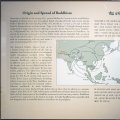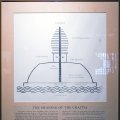Patan Museum (Nepal): photo 117
Photo 117 of 212 in Gallery: Patan Museum (Nepal)

Image title: Buddhist Rites at Swayambhu Stupa
Description of the photo
Buddhist Rites at Swayambhu Stupa; Nepal, 19th century, opaque watercolors and gilt on cotton.
The central feature of this commemorative painting is the great stupa of Svayambhu [Swayambhu]. The stupa is supported by a lotus blossom whose stalk rises from the lake that once filled the Kathmandu Valley. Although the painting is of moderate artistic merit and badly worn, it is interesting for its content.
The cube below the ringed finial represents the Buddha‘s eyes. The little curl between the eyes is a special tuft of hair (urna). one of the signs of a great personage, therefore the sign of a Buddha. The question-mark shape just below symbolizes the light rays the urna emirs. These features are notable in many Nepalese stupas.
The cross-sectioned dome features the multi-armed goddess Usnisha-vijaya. She emanates from the Transcendent Buddha Vairochana, who presides at the top of the painting along with his Five-Buddha companions. Both Usnisha-vijaya and Vairochana are white. The goddess is thought to dwell within the stupa, along with a self-created flame (svayambhu jyotirupa).
Twelve other cloud-borne Buddhist deities, complemented by four fierce guardian figures, surround the stupa. Avalokiteshvara. the Bodhisattva of compassion, sirs below on the jewelled plinth with his consort.
A lower register depicts a Newar lite cycle ritual known as buralburi jankwa or bhintaratha. At certain ages, usually beginning with 77 years, 7 months, and 7 days, Newar men and women are thought to enter quasi-immortality during this ceremony. A special earring is bestowed upon each person who completes one or more such initiations.
In the lowest register Kubera. the god of wealth, sirs between groups of male and female donors. He holds a mongoose under his arm a symbolic source of riches. Four more splendidly garbed donors hover on clouds near the stupa’s garlanded finial.
Gallery information:
The Patan Museum is located on the Durbar square of Patan (Lalitpur/Lalitapura, Kathmandu, Nepal) which is associated Keshav Narayan Chowk (Keshavnarayan)—a form of Lord Vishnu. Being listed as a World Heritage Site, the whole of Durbar square is filled with exquisite temples, sculptures and other ancient structures, of which the ancient history history can be traced to the Malla Kings of Lalitpur. It is an important site for both Buddhism and Hinduism.
Photo details:
Date: 2019-12-02
Camera: SONY ILCE-6400
Exposure: 1/160
Aperture: f/3.5
ISO: 2000
Focal length: 18mm
High resolution:
Download file
Size: 6.23 MB
Resolution: 2550 x 3600
© Photograph by Gabe Hiemstra.
License: CC BY-NC-ND 4.0

